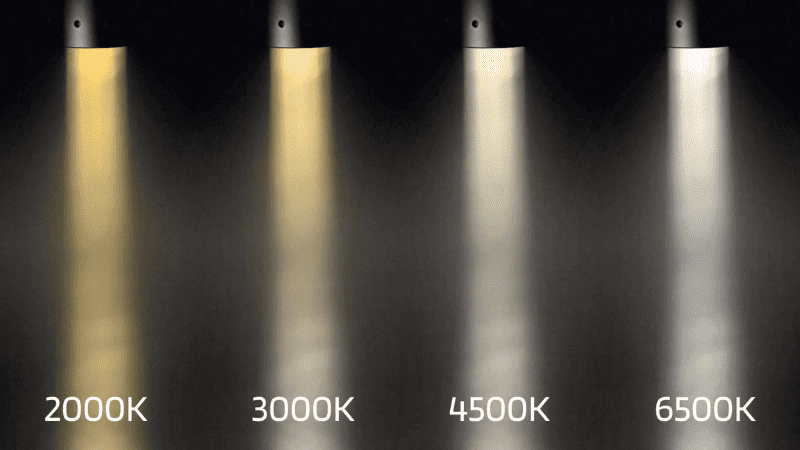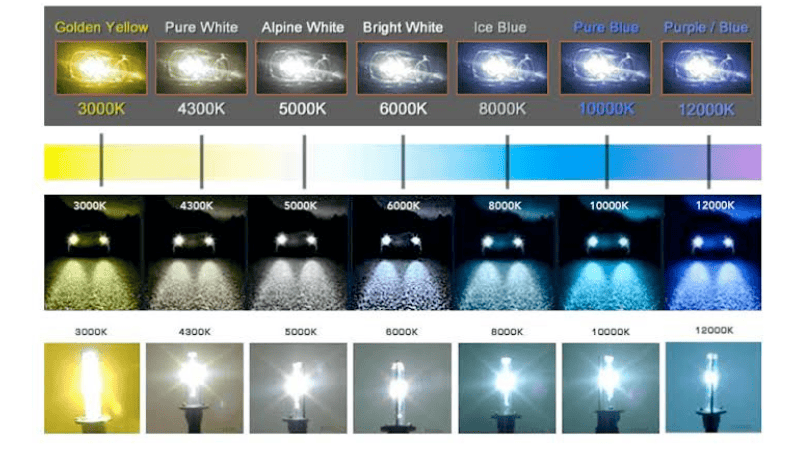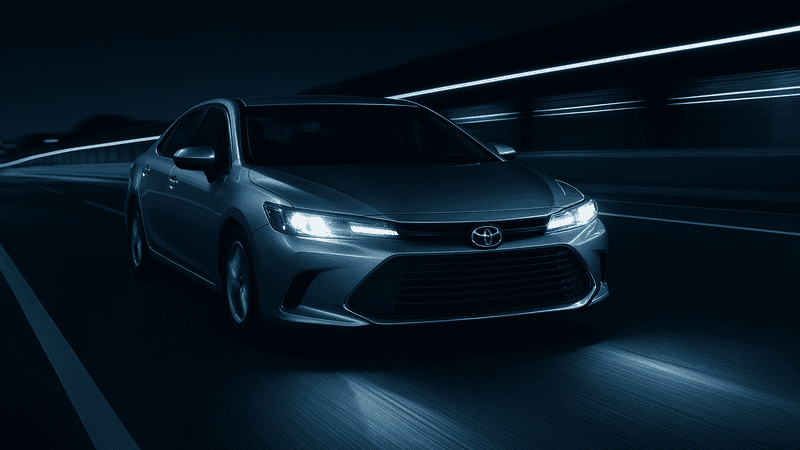In this comprehensive guide, we’ll explore various color temperatures and their impact on visibility and eye comfort. We’ll also dive into why a higher color temperature might be your best choice. By the end of this article, you’ll be equipped with the knowledge to determine which colors are best for LED headlights, ensuring a perfect blend of style and practicality for your vehicle.
Let’s explore the key aspects of LED color selection to ensure you choose the best color for your headlights.
Understanding Color Temperature in LED Headlights
The concept of color temperature is crucial when selecting the ideal LED headlight bulbs for your car. It informs you about the light’s hue, which is key for both visibility and aesthetic appeal. This value is measured in Kelvin (K) and can greatly influence your night-time driving experience. A lower Kelvin indicates a yellow light, often used in fog lights, due to its ability to reduce glare and penetrate poor weather conditions, enhancing the driver’s ability to see.

Conversely, higher Kelvin ratings yield a cooler blue hue, which can sometimes result in decreased light output. While such bulbs may look stylish and modern, they are less optimal in foggy scenarios as the blue LEDs tend to scatter more, reducing visibility. It’s this scattering effect that can lead to decreased light output, potentially making it harder for the human eye to navigate the road.
The optimal range for headlight bulbs, striking a balance between luminosity and comfort for the human eye, usually falls in the middle of the Kelvin scale. These bulbs emit a clear, bright white light, closely mirroring the characteristics of natural daylight, which is conducive to the human eye’s perception of light conditions.
When considering LED lighting for your vehicle, it’s imperative to factor in the lighting conditions you frequently encounter. For example, if you often drive in areas with poor street lighting or adverse weather conditions, you might prioritize headlight bulbs that favor brightness over style, maximizing visibility without compromising safety. On the other hand, if style is a significant concern and you drive in well-lit urban areas, you may opt for headlight bulbs with a higher Kelvin rating.
Additionally, the power consumption of LED bulbs is generally lower than traditional HID bulbs, which not only conserves energy but also may contribute to decreased light output. This is a trade-off worth considering when choosing the right bulb for your car’s headlights.
Therefore, when selecting headlight bulbs, consider the decreased output associated with cooler temperatures and prioritize a color temperature that enhances visibility for the human eye. Balancing these considerations will ensure that your vehicle is equipped with the most effective lighting for safety, performance, and style.
Common Color Options for LED Headlights

When it comes to LED headlights, the color output is a critical factor that affects both the aesthetics of your vehicle and the driving experience. The common color options for LED headlights include:
1. White:
Offering a balance between style and functionality, white LED headlights with a color temperature of around 5000K provide excellent visibility for night driving. These lights are bright and closely mimic natural sunlight, making them easier on the eyes and a popular choice for drivers.
2. Yellow Light:
With a color temperature of about 3000K, yellow lights are preferred for fog lights. The yellow spectrum cuts through fog and rain, reducing glare and improving visibility during inclement weather.
3. Blue:
Blue LED bulbs, with a color temperature of 8000K, add a stylish, high-tech look to your vehicle while still providing adequate visibility. The blue spectrum can be bright, but it may not be optimal in foggy or rainy conditions.
4. Purple:
At the higher end of the spectrum, purple LEDs (around 12000K) are mainly chosen for their unique style. While they make a statement, they’re not the best for visibility and are not recommended for headlight bulbs.
Here’s a simple table summarizing these options:
| LED Color | HID Equivalent | Best For |
|---|---|---|
| White (100%) | 5000K-5500K | Visibility, Night Driving |
| Yellow (90%) White (10%) | 3000K – 4300K | Fog Lights, Poor Weather Conditions |
| Blue (60%) White (40%) | 6000K-80000K | Style & Nighttime Visibility |
| Purple (90%)White (10%) | 12000K | Style |
When selecting the best color for LED headlights, it’s important to consider the Kelvin scale, which measures the color temperature of light. The scale ranges from warm yellow to cool blue, with white light in the middle. Remember, while cooler light can appear brighter to the human eye, it’s not always the best for visibility, especially in adverse weather conditions.
Each color option offers a different beam pattern and light output, and the right choice depends on your specific needs and preferences. For instance, cooler bulbs might offer higher brightness but consume more power. In contrast, warmer bulbs like yellow LEDs use less power and are better suited for fog and decreased visibility conditions.
Optimal Color Choices for Different Environments
When selecting the best LED headlight color, considering the environment where you drive is key. Whether you find yourself in urban settings, rural areas, or facing various weather conditions, the right LED headlight can make all the difference.
Urban vs. Rural Settings
In cities where street lighting is common and traffic is dense, white LED headlights are optimal. They provide a bright, clear light that helps in identifying pedestrians, cyclists, and road signs without overwhelming the already well-lit surroundings. White LED headlights have a color temperature of about 5000K to 5500K, which is close to natural daylight and offers clear visibility.
On the other hand, in less illuminated rural areas, the higher brightness of LED headlights is beneficial. A color temperature of 6500K, which is slightly cooler than sunlight, provides excellent visibility without the high glare that can come from bluer lights.
Weather and Driving Conditions vs Fog Lights
- Clear Conditions: For clear nights, white LEDs are the best choice for both visibility and distance, aiding in safer night driving.
- Foggy Conditions: Yellow light, with a color temperature around 3000K, is best for fog lights. The yellowish hue offers better penetration through fog, rain, or snow without causing glare, making it safer for you and other drivers.
- Rain and Snow: Similar to fog, yellow LED lights are recommended due to their stronger penetration and reduced glare, making driving in rain and snow safer by increasing visibility and reducing eye strain.
Remember that the color temperature of your headlights can impact safety and visibility. While cooler temperatures like 8000K can appear more modern, they may not offer the best visibility and can be less effective in poor weather conditions. The brightness of the bulbs, measured in lumens, is not solely dependent on the color temperature. Higher kelvin bulbs do not necessarily mean brighter light; in fact, very high kelvin ratings can decrease visibility.
Overall, 6500K white light is the most versatile and generally the safest choice for LED headlights, providing a balance between brightness and color temperature, which is important for night driving and various environmental conditions.
Aesthetic Appeal of Different Colors
The LED headlight is not just a functional element of a vehicle; it’s also a statement of style. Different headlight colors can significantly enhance the appearance of any car, making it stand out on the road.
White LEDs: The most popular choice, white light bulbs emit a color temperature of around 5000-5500k, resembling natural sunlight. This clear, bright white light can give vehicles a contemporary and sophisticated look, similar to what you might expect from high-end stock halogen bulbs.
Yellow Stuff: Often used in fog light bulbs, a warmer yellow tint, with a color temperature of around 3000k, casts a glow that can add a vintage or classic touch to a vehicle’s front fascia. The yellow stuff is not just for fog lights; it also infuses a touch of retro appeal.
appeal.
Cool White: Moving up the color temperature scale, LED bulbs that emit a cooler light around the 6000k range blend a modern vibe with increased brightness. They’re a step up from the traditional white lights and offer a crisp aesthetic without venturing into the more intense blue spectrum.
Blue Light: Blue headlights, with their higher color temperature, can project a futuristic ambiance. Although not as commonly used in standard LED lighting due to potential visibility issues, blue lights can make a bold statement in terms of style.
In the world of automotive LED lighting, the LED bulb you choose can influence the light output and the overall look of your vehicle. While HID bulbs have been known for their intense brightness, LED technology has advanced to where you can enjoy both the aesthetic and practical benefits. It’s essential to balance the color rendering index, which affects how colors are seen under the light emitted by the bulbs, with the desired visual effect.
Remember, while the aesthetic appeal is important, so is functionality. The best light bulb for your vehicle will provide a balance of the two, ensuring safety with an appealing beam pattern that complements your car’s design.
Choosing the Right Color for Your Vehicle
Selecting the right LED bulbs for your vehicle involves several key considerations. Firstly, the compatibility of the LED bulbs with your existing headlight bulb setup is crucial. Ensure that the LED bulbs you choose can seamlessly replace your current halogen bulbs or HID bulbs without any issues.
The LED color is another vital aspect. While white light bulb options are popular due to their clear illumination and close resemblance to daylight, exploring other hues can add a unique touch to your vehicle. For instance, bulbs with an orange hue or more coating can offer a distinct look, but remember, the wavelengths needed for optimal visibility shouldn’t be compromised.
Also, consider the longevity and light output of the LED bulbs. LEDs are favored for their longer lifespan compared to traditional light bulbs, but their brightness, measured in lumens, should meet your driving needs.
Lastly, check the legal regulations in your area. Some LED colors might not be street-legal, limiting your options. The market offers a variety of bulbs, but ensuring they adhere to local laws is essential for a hassle-free driving experience.
Professional Consultation and Installation
Selecting and installing the right headlight bulb for your car requires expert knowledge, especially considering the main differences between bulb types available on the market. Professional consultation is key to understanding which bulb – be it LED, HID, or halogen – suits your car’s needs. Experts can guide you on the impact of different bulbs on your car’s high beam performance, a crucial aspect of night driving.
When installing a new headlight bulb, professional handling ensures that the power output is compatible with your car’s system, avoiding potential electrical issues. They can also help in aligning the headlight correctly to maximize the beam pattern, which is crucial for both HID and LED bulbs.
Additionally, professionals can advise on the legality and practicality of different colors, like purple, which may be more about style than functionality. Relying on experts guarantees that your car’s headlights are not only aesthetically pleasing but also functionally sound, enhancing safety and performance.
Conclusion
Selecting the right color for your LED headlights is a decision that consists of both aesthetic and functional considerations. From understanding color temperature and its impact on visibility to considering the specific requirements of your driving environment, this guide has aimed to provide you with comprehensive insights into making the best choice for your vehicle.
Whether it’s the bright visibility offered by white LEDs, the fog-penetrating qualities of yellow lights, or the stylish statement of blue or purple hues, the ideal LED headlight color is a balance between your personal preferences, safety, and legal requirements.
Partner with Carlightvision for Premium LED Headlights
Experience the ultimate in automotive illumination with Carlightvision’s premium LED headlights. Our products are not just about enhancing your car’s appearance; they’re about revolutionizing your driving experience with the perfect blend of style, efficiency, and safety. Ready to light up your path with the best in LED technology? Visit Carlightvision today to explore our diverse range of high-quality lighting solutions.




